Ultimate Guide to Choosing the Perfect Entryway Rug: Size, Shape, Material & More
The moment guests step through your front door, their first impression of your home begins. What greets them? More often than not, it’s your entryway rug. Far more than just a decorative accent, the right rug at your entrance serves as a silent greeter, a guardian of cleanliness, and a subtle statement of your personal style. It’s an essential element that can instantly transform your space, adding warmth and sophistication while protecting your floors from the daily onslaught of dirt and moisture.
However, selecting the perfect entryway rug is not a decision to be taken lightly. It involves a thoughtful balance of aesthetics and practicality. A rug that’s too small can look lost and insignificant, failing to adequately cover the space or fulfill its protective duties. Conversely, an oversized rug can overwhelm your entryway, making the area feel cramped and visually chaotic. This comprehensive guide is designed to empower you with all the knowledge you need to make an informed choice, ensuring your entryway rug is both beautiful and functional.
We’ll delve deep into every crucial aspect, from meticulously measuring your entryway to understanding the nuances of different rug sizes and shapes. We’ll explore various materials, discussing their durability, ease of maintenance, and suitability for high-traffic areas. Furthermore, we’ll provide indispensable tips for keeping your rug securely in place and maintaining its pristine condition over time. By the end of this guide, you’ll be ready to choose the ideal carpet that not only complements your home’s aesthetic but also stands up to the demands of everyday life.
What is an Entryway Rug and Why Does it Matter?
An entryway rug is a crucial piece of home decor, specifically designed to be placed at the threshold of your home’s main entrance. It serves as a multifunctional bridge between the outside world and your interior living spaces. Understanding its various roles highlights why careful selection is so important:
- Primary Purpose: Dirt and Moisture Trap: The most practical function of an entryway rug is to act as the first line of defense against outdoor elements. It efficiently captures dirt, dust, mud, and moisture from shoes, preventing these unwanted particles from being tracked deeper into your home. This significantly reduces the amount of cleaning required for your main flooring and helps maintain a cleaner, healthier indoor environment.
- Setting the First Impression: As the very first decorative item encountered by anyone entering your home, the entryway rug plays a pivotal role in establishing your home’s style and ambiance. It’s a golden opportunity to make a welcoming statement, reflecting your taste and hinting at the comfort and character found within. The rug’s color, pattern, and texture can immediately convey a sense of elegance, coziness, or modern sophistication.
- Enhanced Safety: Entryway rugs significantly contribute to safety, especially on smooth flooring materials like hardwood, tile, or polished concrete. They provide a much-needed non-slip surface, which is particularly vital during wet or snowy weather when shoes can track in water, creating hazardous conditions. A well-placed rug helps prevent slips and falls, offering peace of mind for residents and guests alike.
- Floor Protection: Beyond trapping dirt, entryway rugs act as a protective barrier for your expensive underlying flooring. They shield your floors from excessive wear, scratches, scuffs, and stains caused by heavy foot traffic, shoe debris, and the impact of dropped items. This extends the life and maintains the pristine appearance of your main flooring, saving you money on repairs and refinishing in the long run.
- Added Comfort and Warmth: Stepping onto a soft, inviting rug after a long day or on a cold morning provides a pleasant tactile experience. Entryway rugs introduce a layer of comfort and warmth, transforming a potentially cold, hard surface into a more inviting and cozy space. This small touch can make a big difference in how your home feels right from the start.
- Noise Reduction: In entryways with hard flooring, foot traffic can often generate a lot of echoing noise. Rugs are excellent sound absorbers, mitigating the sounds of footsteps, closing doors, and general activity. This contributes to a quieter, more peaceful home environment, especially beneficial in open-concept layouts where sound travels easily.
- Design Versatility and Seasonal Updates: Entryway rugs come in an astonishing array of sizes, shapes, materials, colors, and designs, offering immense versatility. They can be easily changed to refresh your entryway’s look, adapt to seasonal decor themes, or simply update your home’s aesthetic without committing to major renovations. This flexibility allows for continuous personalization and style evolution.
When selecting your entryway rug, always keep these factors in mind. Given that this area typically experiences high foot traffic and direct exposure to outdoor elements, prioritizing durability, ease of cleaning, and the right size and material is paramount. The perfect entryway rug seamlessly blends functionality with impeccable style, crafting an inviting and protected entrance to your home.
Choosing the Best Rug Sizes for Different Entryways
The size of your entryway rug is perhaps the most critical decision, directly impacting both the aesthetic appeal and the functional effectiveness of your space. A poorly sized rug can throw off the entire balance of your entryway. Here’s a detailed guide to help you select the ideal rug size based on your entryway’s dimensions and layout:
1. Small Entryways and Compact Foyers
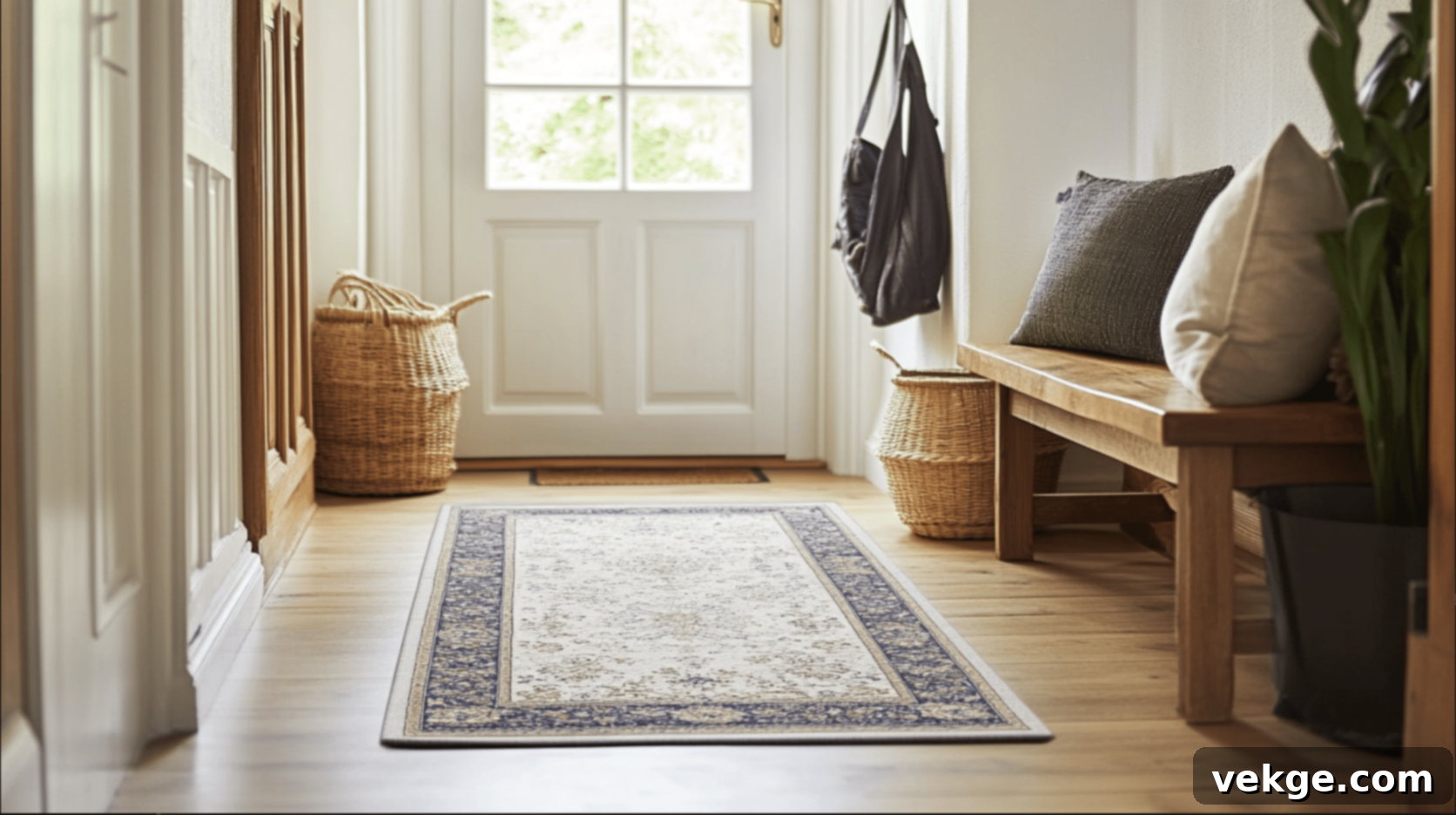
- Ideal Rug Sizes: 2’x3′, 3’x5′, or a slim 2’x6′ runner.
- Considerations: For truly compact spaces where the door opens directly into a small area, a 2’x3′ rug offers just enough space to wipe feet without obstructing the door swing. A 3’x5′ rug is excellent for slightly larger but still cozy foyers, providing a more substantial visual presence. If your small entryway is narrow and extends a bit, a 2’x6′ runner can create a sense of depth without feeling cramped.
- Placement Tip: Aim to leave at least 6 to 12 inches of visible flooring around the edges of the rug. This “breathing room” prevents the rug from looking like a wall-to-wall carpet and allows your flooring to act as a natural frame. Ensure the rug is centered or aligned with the main walking path.
2. Spacious Entryways and Grand Foyers
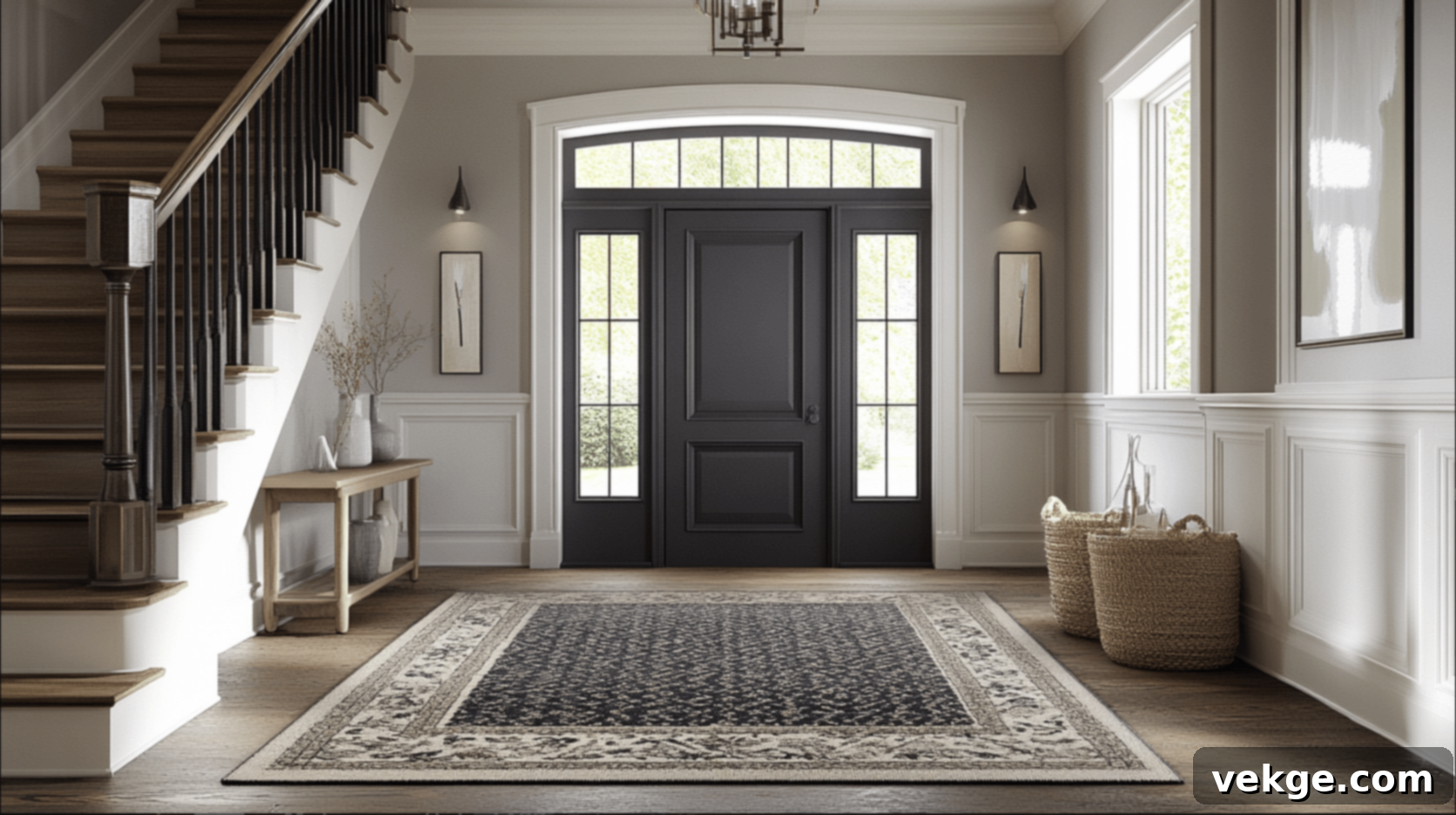
- Ideal Rug Sizes: 4’x6′, 5’x8′, 6’x9′, or even 8’x10′.
- Considerations: In generous entryways, a larger rug can make a dramatic design statement and effectively anchor the space. These sizes allow for more elaborate patterns and colors to truly shine. A 5’x8′ rug is a versatile choice for many medium-to-large foyers, while 6’x9′ or 8’x10′ rugs are perfect for grand entrances or those with high ceilings, helping to ground the space.
- Placement Tip: The rug should define the central area without feeling like it’s touching every wall. It should also not interfere with the swing of any doors or obstruct the placement of entryway furniture like console tables or benches. Ensure there’s ample walking space around the rug.
3. Long, Narrow Hallways and Corridors
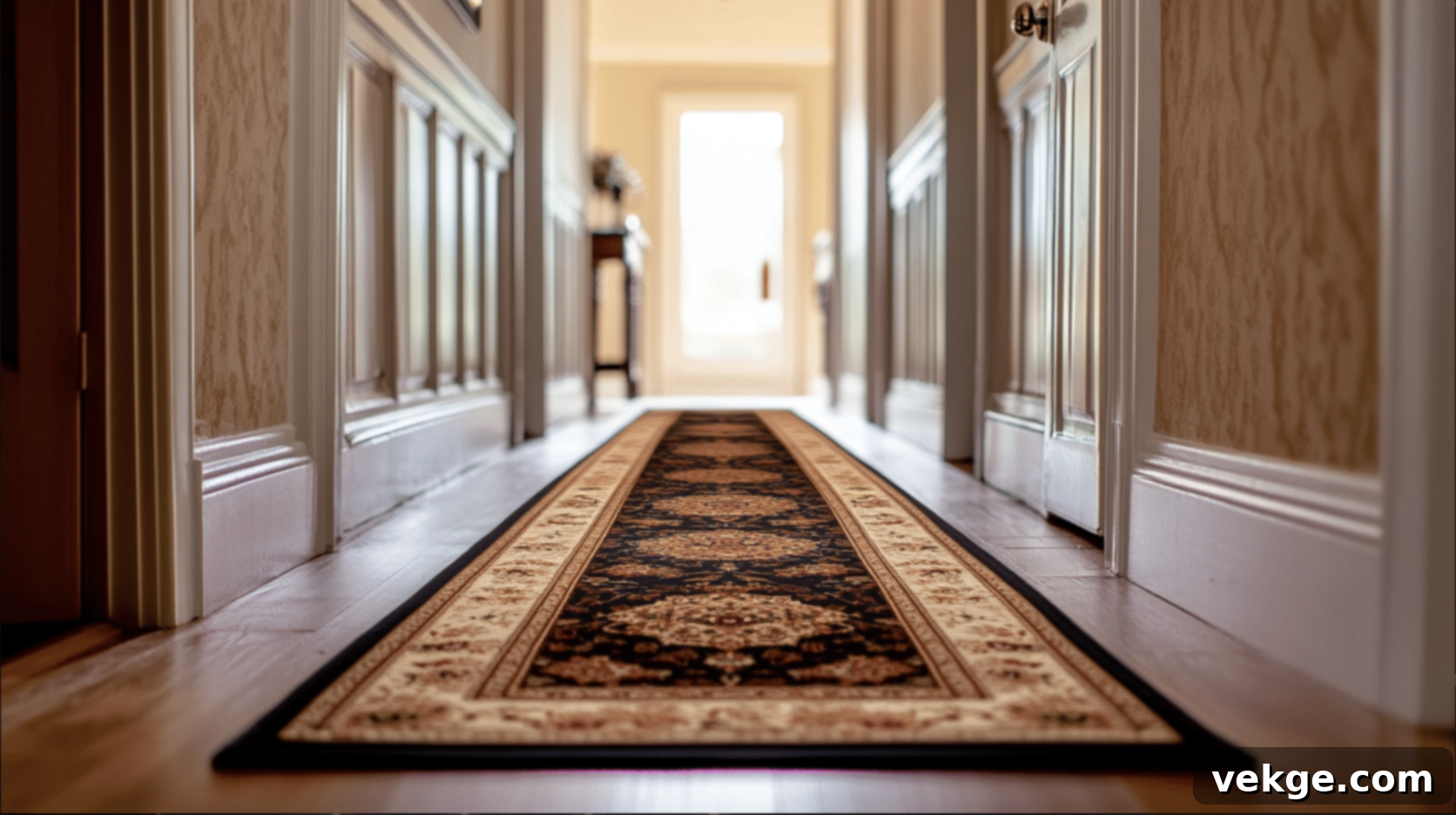
- Ideal Rug Sizes: 2’x8′, 2’x10′, or 3’x10′ runners.
- Considerations: Runner rugs are purpose-built for hallways. They draw the eye down the length of the space, creating a sense of direction and flow. The key is to choose a length that leaves equal, generous space at both ends of the hallway – typically 12-18 inches from the wall or the start of another room.
- Placement Tip: The width of the runner is also important. It should allow for at least 4-6 inches of visible flooring on either side, preventing it from looking too wide for the corridor. A runner should provide a comfortable path for walking, guiding visitors through the space.
4. Double Door or Wide Entryways
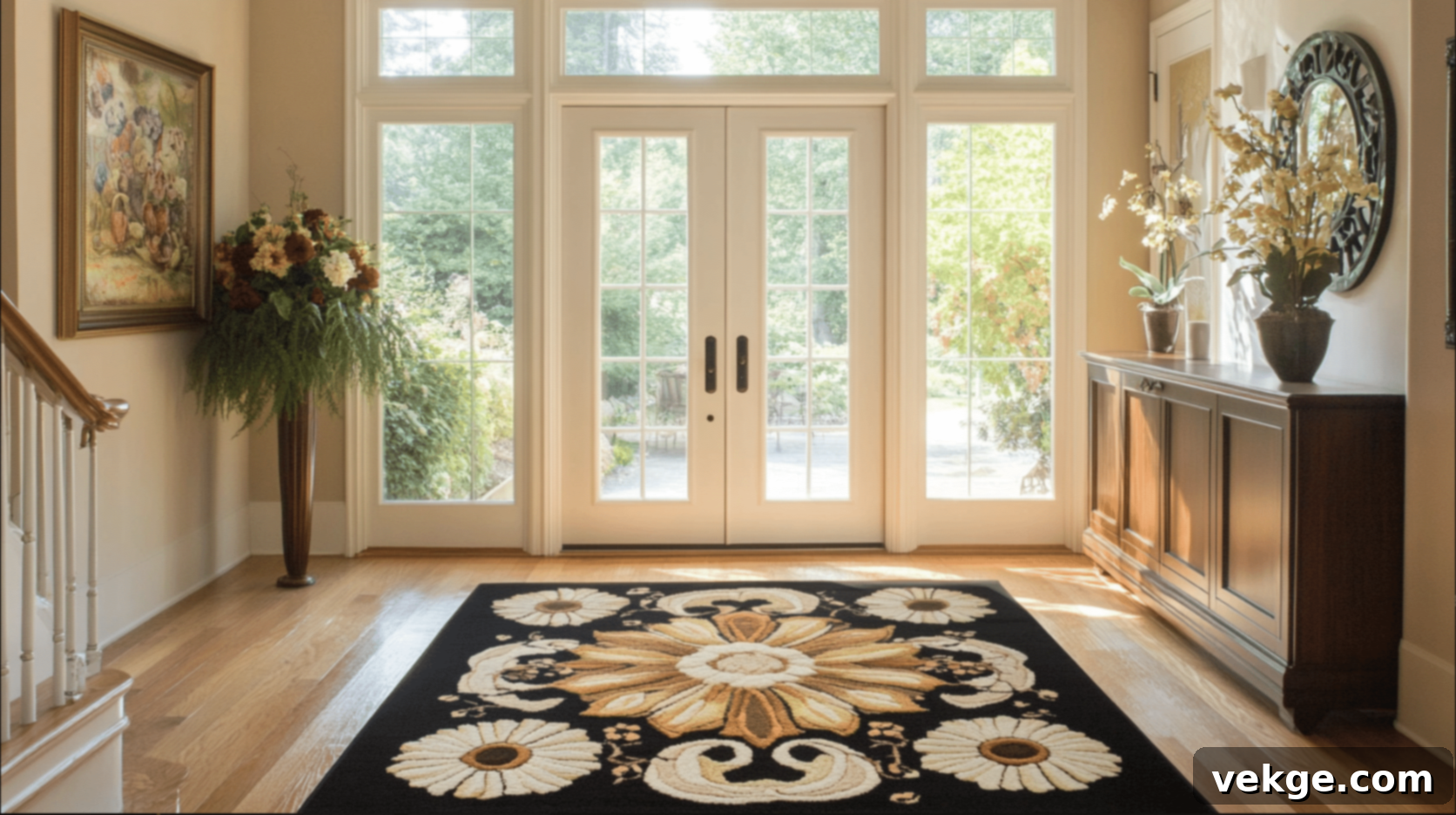
- Ideal Rug Sizes: 5’x8′ or 6’x9′ rectangular rugs are often suitable. For truly square-shaped entryways, consider a 6’x6′ or 8’x8′ square rug.
- Considerations: Entryways with double doors or those that are notably wider than they are long require rugs that can fill the breadth of the space. A rectangular rug that mirrors the width of your double doors can create a cohesive and grand entrance.
- Placement Tip: For square entryways, a square rug naturally complements the room’s geometry, creating a balanced and harmonious look. Ensure the rug is centered and leaves adequate perimeter space.
5. Circular Foyers or Spaces with Curved Elements
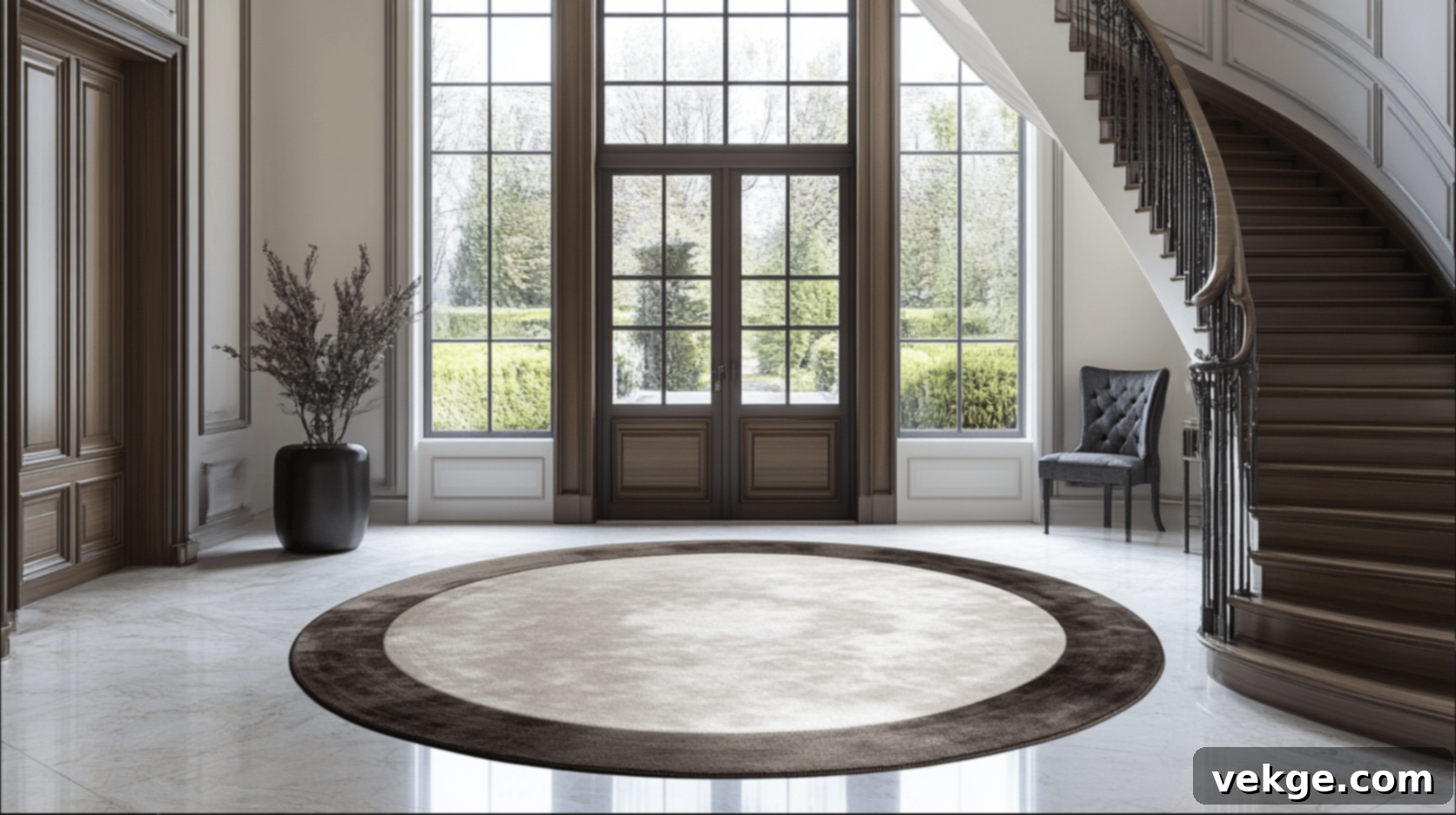
- Ideal Rug Sizes: 6-foot or 8-foot diameter round rugs.
- Considerations: Round rugs are a fantastic choice for circular entryways or those that feature prominent curved architectural elements like spiral staircases or arched doorways. They soften the hard lines of walls and furniture, promoting a sense of flow and elegance.
- Placement Tip: The rug should be perfectly centered within the circular space to achieve a symmetrical and polished appearance. Avoid choosing a round rug that feels too small for the area; it should comfortably define the center without being dwarfed.
How to Accurately Measure Your Entryway
Before purchasing, always measure your specific entryway. Here’s how:
- Map the Area: Determine the exact space where you envision the rug. Consider where the door opens, any furniture, or adjacent archways.
- Measure Length and Width: Use a tape measure to get accurate dimensions of this area.
- Account for Clearance: Subtract at least 6-12 inches from each side to leave visible flooring. For doors, ensure at least 6-8 inches of clearance for the door to swing freely over the rug.
- Visualize with Tape: A powerful tip is to use painter’s tape to outline potential rug sizes on your floor. This allows you to visually assess how different dimensions will fit and feel in your entryway before committing to a purchase.
By carefully considering these guidelines and taking precise measurements, you can confidently choose an entryway rug that perfectly complements your space, both functionally and aesthetically.
Sizing Up Your Space: Selecting Entryway Rug Shapes and Sizes
Beyond just size, the shape of your entryway rug significantly influences the overall flow and aesthetic of your entrance. Pairing the right shape with your specific space can elevate your home’s design, creating a more cohesive and welcoming environment.
1. Choosing the Right Shape for Your Entryway

The layout and architectural features of your entryway should guide your rug shape selection. Different shapes naturally enhance various types of spaces:
- Long and Narrow Entryways (Hallways): Runner rugs are the undisputed champions for these spaces. Their elongated form perfectly mirrors the shape of the hallway, drawing the eye forward and creating a sense of depth and continuous flow. When placing, center the runner, ensuring at least 6-12 inches of visible floor on either side to prevent a cramped look. Standard runner sizes range from 2’x6′ to 3’x12′, but custom lengths are also available for unusually long corridors.
- Wide or Open Foyers: Rectangular or square rugs are ideal for defining these more expansive spaces. A large rectangular rug can anchor the main seating area of a foyer, establishing a distinct zone. A square rug, on the other hand, perfectly complements a square-shaped foyer, creating visual harmony and symmetry, especially under a central light fixture or grand chandelier. Sizes like 6’x9′ or 8’x10′ for rectangular and 6’x6′ or 8’x8′ for square rugs can add significant warmth and an inviting atmosphere.
- Entryways with Circular Elements: If your entrance features rounded architectural details, such as a grand circular staircase, a vaulted domed ceiling, or a round decorative table, a round rug can beautifully soften angular lines and introduce a harmonious flow. Round rugs foster a sense of balance and can be particularly effective in making a space feel more dynamic and less rigid. Sizes typically range from 4-foot to 8-foot diameters.
- Uniquely Shaped or Irregular Entryways: For entryways that don’t conform to standard rectangular or square layouts, you might consider custom-shaped rugs or even layered rugs. An oval rug can offer a softer alternative to a rectangle while still providing an elongated form.
2. Matching Shape to Architectural Features

Consider how the rug shape interacts with existing architectural elements to create a cohesive design:
- Rectangular Rugs: These are the most versatile and work best in traditional long, narrow spaces or standard rectangular foyers. They provide a classic, structured look that complements most home designs and furniture layouts.
- Round Rugs: Excellent for square or circular spaces, round rugs excel at creating a focal point. They are particularly effective when placed under a statement chandelier, within foyers featuring arched doorways, or in spaces with curved walls. They introduce a sense of movement and softness.
- Oval Rugs: Offering a unique blend, oval rugs provide the elongated coverage of a rectangular rug with the softer, continuous lines of a circular one. They can be a great compromise for entryways that are somewhat narrow but benefit from less rigid forms, or to echo an oval dining table nearby.
3. Critical Sizing Considerations for Both Looks and Functionality
Beyond selecting the perfect shape, precise sizing is paramount to ensure your entryway rug enhances rather than detracts from your space:
- The “Framing” Rule: A general guideline is to leave at least 6 to 18 inches of visible flooring around the rug’s edges. This creates a polished, “framed” look, allowing your beautiful flooring to show and preventing the rug from overwhelming the room. For smaller entryways, stick to the lower end (6-10 inches); for larger foyers, you can afford more space (12-18 inches).
- Small Entryways: In truly compact spaces, a 3’x5′ rug might be the largest you can accommodate comfortably. If the space is more of a short, narrow corridor, a 2’x6′ runner could be ideal, providing sufficient coverage without feeling cramped.
- Large Foyers: More generous spaces can easily accommodate larger rugs, ranging from 8’x10′ to 9’x12′ or even larger, depending on the room’s overall dimensions. The goal is to define the main traffic area without making the space feel smaller.
- Essential Door Clearance: This is a non-negotiable factor. Always ensure the rug’s height and placement allow for proper door clearance. The door must be able to open and close freely over the rug without snagging or dragging. If your door has minimal clearance, opt for a low-pile rug or test the rug’s thickness before purchasing.
Remember, the harmonious combination of the right shape and size can dramatically enhance your entryway’s appearance, functionality, and overall welcoming vibe. Take the time to measure, visualize (perhaps with painter’s tape), and consider how different options will truly fit and elevate your unique space before making your final decision.
Entryway Rug Fabrics: Making the Right Material Choice for Durability and Style
The material of your entryway rug is a critical factor, directly influencing its durability, resistance to stains, ease of cleaning, and overall feel. Given that entryway rugs face constant foot traffic, dirt, and moisture, selecting a robust and appropriate fabric is key to its longevity and performance. Here’s a breakdown of popular natural and synthetic fiber options:
Natural Fiber Options

- Wool: Often considered the gold standard for rugs, wool is a premium choice for entryways. It’s inherently durable, resilient, and possesses natural stain and water resistance due to its lanolin content. Wool rugs can withstand heavy foot traffic, bounce back from compression, and maintain their appearance beautifully over time. They are also naturally flame-retardant and excellent at hiding soil. While they are luxurious and comfortable underfoot, wool rugs tend to be more expensive than other options and may shed initially.
- Jute and Sisal: These plant-based natural fibers are celebrated for their exceptional durability, coarse texture, and eco-friendly qualities. Jute (softer) and sisal (firmer, more durable) rugs offer a rustic, organic appearance that can add significant visual interest and texture to your entryway. They are outstanding at trapping dirt and debris, making them highly practical choices for active households. However, they can be rough underfoot, may absorb liquid spills quickly if not treated, and can be more challenging to clean thoroughly compared to synthetic options. Sisal, in particular, should not be exposed to excessive moisture.
- Cotton: Cotton rugs are a soft, affordable, and versatile choice, often available in a wide array of colors and patterns. Many cotton rugs are machine-washable, making them incredibly convenient for quick clean-ups, which is a major benefit in an entryway. However, they are generally less durable than wool or synthetics like nylon and may show wear and tear more quickly in high-traffic areas. They can also be prone to shrinking if not washed carefully.
- Seagrass: Similar to jute and sisal, seagrass offers a distinct natural look with a smoother, slightly waxy feel. It’s highly durable, water-resistant, and relatively easy to clean, making it a good choice for entryways prone to moisture. However, seagrass typically isn’t dyed, limiting color options, and can also be somewhat stiff underfoot.
Synthetic Fiber Options

- Nylon: Nylon is a powerhouse among synthetic fibers, renowned for its exceptional durability, elasticity, and superior stain resistance (especially when treated). It can withstand extremely heavy foot traffic without matting or crushing, making it an ideal choice for the busiest of entryways. Nylon rugs are easy to clean, quick to dry, and come in an extensive range of colors and patterns, offering great design flexibility.
- Polypropylene (Olefin): This synthetic material is incredibly popular, especially for indoor/outdoor rugs, making it a stellar entryway choice. Polypropylene rugs are highly resistant to stains, moisture, mold, mildew, and fading from sunlight, making them virtually indestructible in challenging environments. They are very easy to clean and maintain, often simply needing a hose down. While they may lack the luxurious softness of natural fibers like wool, their ruggedness and affordability are unmatched.
- Polyester: Polyester rugs are appreciated for their vibrant colors, softness, and affordability. They perform well against water-based stains and resist fading. While not as resilient or durable as nylon for the absolute highest traffic, polyester can still be a good choice for moderate-traffic entryways where comfort and color vibrancy are priorities. However, it can be more susceptible to oil-based stains and may show signs of wear more quickly than nylon or polypropylene.
Factors to Consider When Choosing Your Rug Material
Making the best material choice requires a holistic approach:
- Traffic Level: Objectively assess how much foot traffic your entryway receives. For busy households with kids and pets, opt for highly durable materials like wool, nylon, or polypropylene. For lighter traffic, cotton or polyester might suffice.
- Local Climate: If you live in an area prone to rain, snow, or mud, choose a material that can handle moisture exceptionally well, such as polypropylene (often labeled as indoor/outdoor) or wool, which has natural moisture-wicking properties.
- Budget: Natural fibers like wool tend to be at the higher end of the price spectrum, reflecting their quality and longevity. Synthetic options, particularly polypropylene and polyester, offer more budget-friendly alternatives without sacrificing significant performance.
- Desired Look and Feel: Consider the aesthetic you want to achieve. Do you prefer the plush comfort of wool, the earthy texture of jute, or the sleek appearance of a synthetic? Each material has a unique texture and visual presence that contributes to the overall ambiance of your entryway.
- Ease of Cleaning and Maintenance: Be realistic about how much time you want to spend on rug maintenance. Machine-washable cotton, easily hosed-down polypropylene, or stain-resistant nylon might be preferable for busy individuals compared to spot-clean-only natural fibers.
By carefully weighing these factors against the characteristics of each material, you can confidently select an entryway rug that not only looks fantastic but also stands up to the daily rigors of your home’s busiest transition point, providing both style and practicality for years to come.
No-Slip Strategies: Keeping Entryway Rugs Firmly in Place for Safety and Style
An entryway rug serves many purposes, but none is more critical than safety. A rug that slides or bunches can be a significant tripping hazard, especially in a high-traffic area where people are often rushing or carrying items. Ensuring your entryway rug stays firmly in place is paramount for both safety and maintaining a polished look. Here are the most effective strategies:
1. The Indispensable Role of Rug Pads

Rug pads are the gold standard and most effective method for securing entryway rugs on any hard surface flooring. They provide a vital layer of grip between the rug and the floor, acting as a crucial barrier that prevents slips, slides, and unwanted bunching. But their benefits extend beyond just stability:
- Types of Rug Pads:
- Non-Slip Rubber Pads: These are thin, waffle-patterned pads made from natural or synthetic rubber. They offer excellent grip and are ideal for high-traffic entryways where maximum slip prevention is needed. Look for natural rubber options for better durability and to avoid potential chemical reactions with certain floor finishes.
- Felt and Rubber Combination Pads: These pads offer the best of both worlds. The felt layer provides cushioning, sound absorption, and added insulation, while the rubber bottom ensures superior grip. They are thicker and add a luxurious feel underfoot, helping to prolong the life of your rug by reducing wear.
- Felt Pads (Non-Slip Backing): While primarily for cushioning and floor protection, some felt pads come with a non-slip backing. These are better for larger, heavier rugs that already have some inherent stability, as they offer less aggressive grip than full rubber options.
- Correct Sizing: Always choose a rug pad that is slightly smaller than your rug (typically about 1 inch smaller on all sides). This ensures the pad remains hidden, preventing it from showing at the edges of your rug and creating a clean, finished appearance.
- Additional Benefits: Beyond anti-slip properties, rug pads add a layer of cushioning, making your rug feel more luxurious and comfortable underfoot. They also protect your main flooring from potential scratches and wear caused by the rug’s backing and prevent dye transfer.
2. Supplemental Securing Methods for Enhanced Stability
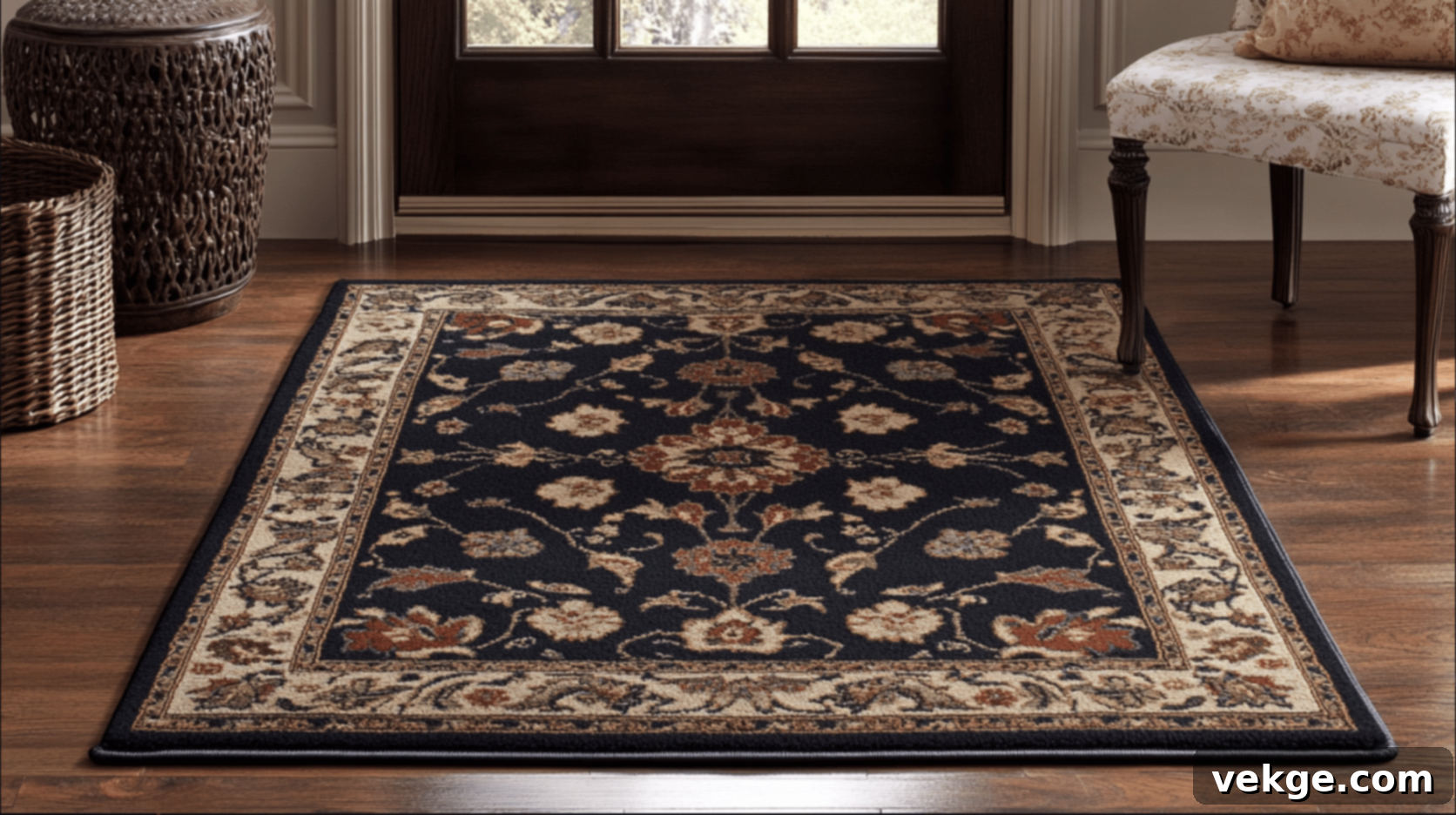
While rug pads are highly effective, for exceptionally busy entryways, very lightweight rugs, or challenging flooring surfaces, you might consider additional securing methods:
- Rug Grippers: These adhesive corner or edge pieces attach directly to the underside of your rug and stick to the floor. Many are reusable and washable, maintaining their stickiness over time. They are particularly useful for preventing corner curling, which can be a significant tripping hazard.
- Double-Sided Rug Tape: This strong adhesive tape adheres to both the rug and the floor, offering powerful slip prevention. For best results, apply strips strategically at all corners and along the edges of the rug, especially on smooth surfaces like tile or polished concrete. Be sure to choose tape that is safe for your specific floor type to avoid residue or damage upon removal.
- Silicone Caulk (Temporary Solution): For small, lightweight rugs that constantly shift, a few dots of clear, removable silicone caulk applied to the underside of the rug (and allowed to dry before placement) can provide temporary grip. This is a more DIY solution and should be tested in an inconspicuous area first.
3. Smart Rug Selection and Strategic Placement
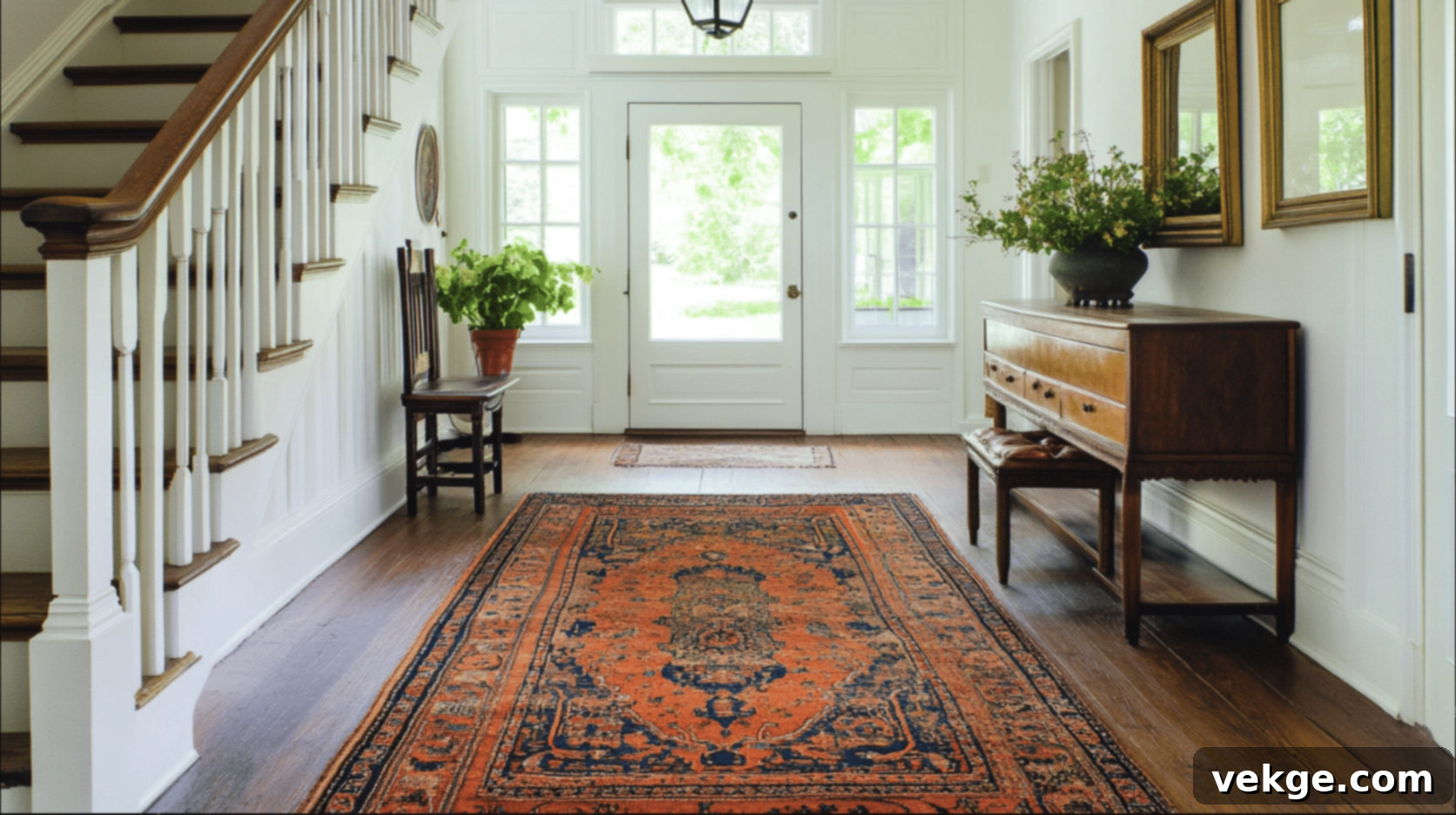
The rug itself and its placement can also contribute to its stability:
- Opt for Low-Pile, Heavier Rugs: In high-traffic entryways, choose rugs with a low pile and a substantial weight. These rugs are inherently more stable and less prone to shifting than lightweight, high-pile alternatives. Materials like wool or durable synthetics with strong backings often fit this description.
- Consider Built-In Non-Slip Backings: Some entryway rugs are manufactured with a non-slip rubber or latex backing. While convenient, always check the quality of this backing; some can degrade over time or react poorly with certain floor finishes. A separate rug pad often provides superior and more reliable grip.
- Strategic Furniture Placement: If your entryway allows, strategically placing a piece of furniture—like a console table, a small bench, or a shoe rack—so that its front legs rest partially on the rug can add weight and stability. However, exercise caution to ensure this placement does not create new tripping hazards or obstruct natural pathways. The furniture should comfortably overlap the rug without making the area feel crowded.
By implementing these no-slip strategies, you can ensure your entryway rug remains a beautiful and safe addition to your home, making a confident and secure first impression for everyone who enters.
Entryway Rug Maintenance: Essential Tips for Cleanliness and Longevity

Given the entryway rug’s critical role as a dirt and moisture trap, it naturally accumulates a significant amount of debris. Regular and proper maintenance is crucial not only for keeping your home clean but also for preserving the appearance, integrity, and lifespan of your rug. Here are comprehensive tips to ensure your entryway rug remains a welcoming feature for years to come:
1. Consistent and Regular Vacuuming
The most fundamental step in rug maintenance is frequent vacuuming. Your entryway rug should be vacuumed at least twice weekly, and even more often in high-traffic households with pets or children, or during inclement weather. This prevents dirt, dust, and grit from settling deep into the rug fibers, which can cause premature wear and dullness.
- Choose the Right Vacuum: Use a vacuum cleaner with adjustable height settings to accommodate different pile heights. For low-pile or flatweave rugs, a suction-only attachment or setting is often best to avoid damaging the fibers or catching edges. For thicker rugs, a beater bar can be effective, but use it carefully to prevent excessive wear.
- Thorough Technique: Vacuum slowly in multiple directions (forward, backward, and diagonally) to dislodge embedded dirt. Pay extra attention to the edges and corners, as well as the areas directly in front of the door, where dirt accumulation is highest.
2. Immediate and Effective Stain Treatment
Spills and stains are inevitable in an entryway, but quick action is key to preventing them from becoming permanent. Always address spills as soon as they occur:
- Blot, Don’t Rub: The golden rule for stain removal is to blot (gently press with a clean, white cloth or paper towel), never rub. Rubbing can spread the stain, push it deeper into the fibers, and damage the rug’s pile.
- Water-Soluble Stains: For most common stains like mud, coffee, or juice, use a mixture of mild dish soap and lukewarm water. Apply the solution to a clean cloth, blot the stain, and then blot with a fresh, damp cloth to rinse.
- Oil-Based Stains: For greasy stains, you may need a dry-cleaning solvent or a specialized rug stain remover. Always read the product instructions carefully and test any cleaning solution on an inconspicuous area of the rug first to ensure it doesn’t cause discoloration or damage.
- Pet Accidents: For pet urine, blot as much as possible, then use an enzymatic cleaner specifically designed to break down pet odors and stains.
- Air Dry: After treating a stain, allow the area to air dry completely. Avoid using heat, as it can set stains.
3. Periodic Deep Cleaning for a Refresh
While regular vacuuming handles surface dirt, deep cleaning is essential to remove accumulated grime and refresh your rug’s appearance. Aim to deep clean your entryway rug every 12 to 18 months, or more frequently (every 6-9 months) if it experiences exceptionally high traffic, has light colors, or is prone to heavy soiling.
- Professional Cleaning: For wool or delicate rugs, or if you’re unsure about DIY methods, professional rug cleaning is often the safest and most effective option. Professionals have specialized equipment and knowledge to clean various rug materials without causing damage.
- DIY Deep Cleaning: If you choose to deep clean yourself, use an appropriate rug shampoo or a rented carpet cleaning machine. Always follow the manufacturer’s instructions for both the rug and the cleaning product. Ensure the rug is completely dry before placing it back in your entryway and putting furniture on it to prevent mold and mildew growth. This can take 24-48 hours depending on humidity.
4. Rotation and Sun Protection
- Rotate Your Rug: To promote even wear and prevent one section from deteriorating faster than others, rotate your entryway rug every few months. This is particularly important for areas that receive direct sunlight or uneven foot traffic.
- Minimize Sun Exposure: Direct and prolonged sunlight can cause rug colors to fade and fibers to degrade over time. Use window treatments like blinds, curtains, or UV-blocking films to minimize direct sunlight exposure on your entryway rug. If your entryway is consistently sunny, consider choosing a rug made from UV-resistant materials like polypropylene, or be prepared for more frequent replacements.
By diligently following these maintenance tips, your entryway rug will not only continue to look its best but will also provide a durable, clean, and welcoming first impression for your home for many years.
Conclusion: Crafting the Perfect Welcome with Your Entryway Rug
The journey to choosing the perfect entryway rug is a meticulous one, involving a careful balance of aesthetic desires and practical necessities. As we’ve explored, it’s about far more than just picking a pretty pattern; it’s about making an informed decision that enhances the safety, cleanliness, and overall appeal of your home’s first impression.
From accurately measuring your entryway to understanding how different sizes and shapes can define and elevate your space, every detail matters. The material you select is equally crucial, dictating your rug’s durability, resistance to daily wear and tear, and ease of cleaning—essential qualities for such a high-traffic area. And, of course, implementing effective non-slip strategies is paramount to ensure your entryway remains a safe and welcoming threshold for everyone.
By thoughtfully considering your entryway’s unique dimensions, the volume of foot traffic it receives, your local climate, and your personal style preferences, you can confidently select a rug that not only meets your functional needs but also serves as a beautiful introduction to your home. Regular maintenance, including consistent vacuuming, prompt stain treatment, and periodic deep cleaning, will ensure your chosen rug retains its beauty and functionality for years to come.
We encourage you to take action today. Measure your entryway with precision, visualize different rug options using painter’s tape, and truly consider how each choice aligns with your lifestyle and decor. Your entryway isn’t just a passageway; it’s the opening statement of your home. Make it count. Transform your entryway and upgrade your home’s welcome with the perfect rug that blends style, safety, and enduring quality!
Frequently Asked Questions (FAQs) About Entryway Rugs
What Size Rug Is Best for A Small Entryway?
For small entryways, a 2’x3′ rug is ideal if the space is very compact and just needs a spot for wiping feet. A 3’x5′ rug offers more coverage and visual presence for slightly larger small entryways. If your small entryway is narrow and extends a bit, a runner such as 2’x6′ or 2’x8′ can be a great option to define the path without overwhelming the space. Always ensure there’s at least 6-12 inches of visible flooring around the rug and ample door clearance.
What Materials Are Best for Withstanding Heavy Foot Traffic?
For high-traffic entryways, durability is key. Wool is an excellent natural fiber choice, known for its resilience, stain resistance, and luxurious feel. Among synthetics, nylon is exceptionally durable, resistant to crushing and stains, making it perfect for busy areas. Polypropylene (often used for indoor/outdoor rugs) is also highly recommended due to its resistance to moisture, stains, fading, and general wear, making it virtually indestructible. Sisal and jute, while coarse, are also very durable natural options for trapping dirt effectively.
How Much Space Should Be Between the Rug and The Door?
It is crucial to leave enough space between the rug and the door to allow the door to open and close freely without dragging or snagging on the rug. A general guideline is to leave about 6-8 inches of clear floor space between the edge of the rug and the door’s swing path. For very thick rugs, you might need even more clearance, or opt for a low-pile rug to ensure smooth operation.
Can I Use an Outdoor Rug in My Entryway?
Yes, outdoor rugs, typically made from polypropylene or other weather-resistant synthetics, are an excellent choice for entryways. They are specifically designed to withstand harsh elements, high traffic, moisture, and stains, making them incredibly durable and easy to clean. Their robust nature makes them perfect for trapping dirt and debris from outside, and they often come in stylish designs that blend seamlessly with indoor decor.
How Do I Choose a Rug Color and Pattern for My Entryway?
When choosing a color and pattern, consider your home’s existing decor, wall colors, and flooring. Lighter colors can make a small entryway feel larger but will show dirt more readily. Darker colors or patterned rugs are excellent for disguising dirt and stains in high-traffic areas. Geometric patterns, subtle textures, or transitional designs often work well in entryways, adding visual interest without being overwhelming. Aim for a rug that complements your home’s overall aesthetic and sets a welcoming tone.
